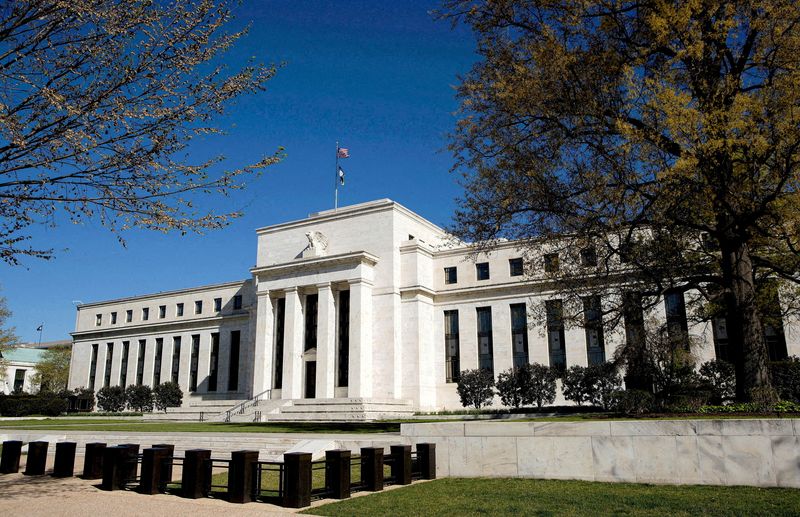With Fed’s rate cut at hand, debate swirls over how big a move
2024.09.18 01:46
By Howard Schneider
WASHINGTON (Reuters) – The Federal Reserve on Wednesday almost certainly will lower interest rates for the first time in more than four years as the U.S. central bank starts to reverse the restrictive conditions it imposed to beat back inflation, but whether policymakers opt for a half-percentage-point cut or smaller move remains up in the air.
Their choice on how they want to kick off a new easing cycle – less than two months before what is expected to be a close U.S. presidential election – likely hinges more on what signal they want to send as they pivot from the highest interest rates in a quarter of a century than about expectations for near-term macroeconomic impact, even as their worries about the job market grow.
A half-percentage-point cut – now given more than a 60% probability in rate futures markets – would signal a commitment to sustaining the current economic expansion and the job growth that goes along with it, something Fed Chair Jerome Powell has said is the top priority now that inflation is approaching the central bank’s 2% target.
A quarter-percentage-point reduction in borrowing costs would be more consistent with how the Fed has begun prior easing cycles outside of any brewing crisis. It would align with the cautious approach policymakers said they were taking towards rate cuts, and track economic data that has shown the economy slowing but not, seemingly, about to crack.
Recent job growth has come down from the high levels of the COVID-19 era, but remains positive; retail sales and industrial production data released on Tuesday beat expectations; and an Atlanta Fed model that tracks estimates of economic growth based on incoming data shows the economy is expanding at a 3.0% annual rate so far in the third quarter, above the central bank’s estimates of U.S. potential.
“We have never come close to a major tipping point on interest rates without more certainty” about how it would start, Diane Swonk, the chief economist at KPMG, wrote on Monday ahead of the start of the Fed’s latest two-day policy meeting. But while a 50-basis-point cut “will no doubt be discussed,” Swonk said, “Powell is unlikely to have the votes.”
Others argued that after the Fed’s last meeting in July, at which several policymakers were open to cutting rates at that time, and with investors flocking towards bets on a half-percentage-point cut, doing less would be seen as failing to deliver on Powell’s statement last month that he did not want the labor market to weaken any further.
“The Fed will deliver a 50-basis-point cut to jump-start the easing cycle and will seek … to reassure that it is not behind the curve and strengthen confidence” that the expansion will continue as inflation eases further, Evercore ISI Vice Chairman Krishna Guha wrote, while noting that there could be as many as three dissents, an unusual fracture of Powell’s efforts to operate by consensus.
INFLATION BATTLE
The Fed’s rate decision and new policy statement are scheduled to be released at 2 p.m. EDT (1800 GMT) along with updated economic projections that will show how much lower policymakers anticipate rates will fall over this year and in 2025. Officials will also update their outlooks for inflation, unemployment and economic growth.
The Fed’s benchmark policy rate has been held in the current 5.25%-5.50% range for 14 months. That is longer than three of the last-six Fed “hold” periods but is short of the 15 months that rates sat unchanged before the 2007-2009 financial crisis and even further shy of the 18-month pause during the “Great Moderation” of the late 1990s.
While the rate decision itself is critical, how Powell describes that choice and the outlook for borrowing costs during his post-meeting press conference may be more so. He is due to begin his remarks half an hour after the release of the policy statement and projections.
The Fed’s decision, the tenor of the statement and Powell’s press conference, and the market’s reaction to it, will come roughly seven weeks before the end of a U.S. presidential election campaign that may turn at least partly on voter perceptions about pocketbook issues like food and housing costs.
In the aftermath of the pandemic, a combination of goods scarcity, massive spending, labor shortages, large government deficits, and aggressive corporate pricing drove inflation to a 40-year high in 2022.
While wage growth was also strong and for many workers exceeded the pace of price increases, sentiment was dour for much of the time as the Fed ratcheted up interest rates to try to slow the economy, home mortgage rates rose in response, and banks curbed credit for many types of loans and borrowers.

Inflation by the Fed’s most watched measure is now about a half a percentage point away from the central bank’s target, and expected to come down gradually through the rest of 2024 and next year.
The economy by almost all measures has fared better than expected through it all, with the Fed now expected to shift gears and offer its first clues on Wednesday about how fast and how far it plans to pivot.








